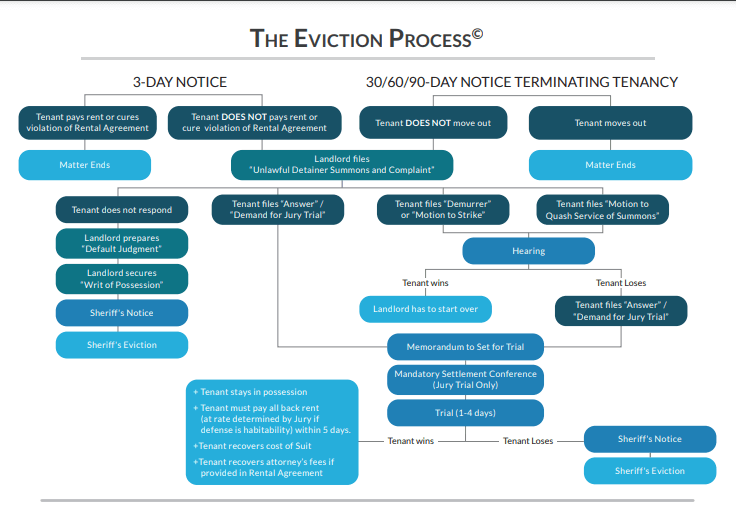
The carefully choreographed steps of the California eviction process
When housing providers endeavor to transition a tenant out of the rental unit, there is a formal eviction process to follow. Documentation is specialized, timelines are unforgiving, and there are many opportunities for the plaintiff landlord to make missteps if they go it alone without proper counsel.
The California eviction process begins with the service of a 3-Day Notice, a topic we discussed in an earlier article. It is crucial to properly draft and serve the notice or it may come back to haunt the landlord.
After the notice is served, the onus is on the tenant to pay rent or remedy other issues stated in the notice. Alternatively, the tenant can vacate, but this is exceedingly rare.
If the tenant meets the landlord’s demands within 3 days (excluding weekends and court holidays), mark the matter as done. If the tenant does not “cure” the underlying issue, the landlord has perfected their right to file an unlawful detainer action, which is a trade word for eviction, in Superior Court. The tenant is then served with court papers, typically including a “Summons and Complaint.”

Now what? Does the tenant respond or do they put their head in the sand?
After being served, the tenant has five days to file a response with the court. If the tenant does not file an Answer or a legally authorized challenge to the lawsuit, our clients can ask for a default judgment, which would likely result in an expedited eviction. In the event the tenant responds, the case will move forward.
The economics of elongating a landlord-tenant dispute
If a trial date is set, we’ll have a settlement conference a week prior, with the strong preference to come up with a mutual agreement for the tenant to move out voluntarily under certain stipulations. Tenants’ attorneys zealously advocating for their clients will attempt to negotiate the most favorable terms for the tenant, and our role is to decide what is reasonable or not.
It may be emotionally painful for housing providers to capitulate to demands such as rent waivers, return of the security deposit, more time to move out, if not cash payments for the tenant to find a new abode; but such arrangement may make more economic sense than hiring Bornstein Law or another attorney to represent you in a trial that can cost upwards to $20,000.
As a last resort, we go to trial.
If a jury trial is demanded, it will typically take 1-to-4 days to air out the lawsuit. If it is a court trial and you go in front of someone in a robe, you can expect it to take less time to come up with a final resolution.
If the judge rules in favor of the landlord, a “Judgment” is issued and the eviction process moves forward. We will request a “Writ of Possession” from the court which authorizes the Sheriff’s office to evict the tenant. In turn, the Sheriff’s office will post a “5-Day Notice to Vacate” at the property. If the tenant chooses to remain, the Sheriff can physically remove the tenant.
Conversely, if the tenant wins, they can remain in the rental unit and may be entitled to costs and/or attorneys’ fees.
How long does the California eviction process take?
In a pre-pandemic world, we would say 90-120 days. For the visual types, we have prepared a chart that illustrates how the California eviction process progresses from start to finish. Although there are some nuances on the local level, the prescribed statewide rules have fundamentally not changed.
Pent-up demand and a phalanx of tenants’ attorneys have elongated the unlawful detainer process.
Although the courts are functioning, patience is necessary as court personnel have been unable to keep up with a deluge of eviction actions, do not have the courtrooms to try cases, or clerks make errors that must be corrected. On top of it, law enforcement is slow to evict given their own lack of human resources and there are brilliant tenants’ attorneys capable of creating demurrers and putting up roadblocks to an eviction action.
Many of our clients are irate, and we share your frustration. Bornstein Law works hard to accomplish the goals of our clients as quickly as possible, but there are some variables outside our control.
Brilliant tenants’ attorneys also create thorns in our side when we deal with demurrers, which is a legal response or pleading that the tenant can file in response to an eviction action.
Essentially, the purpose of a demurrer is to challenge the sufficiency of the complaint on its face, arguing that even if all the facts alleged in the eviction lawsuit are true, the complaint is legally insufficient.
These attorneys might claim a lack of specificity, a defective notice, demanding an improper rent amount, failure to state a cause of action, using multiple causes of actions making it unclear what the tenant can respond to, other actions pending, or simply a lack of details to establish a valid reason for eviction. Another favorite gambit is to claim that the rental unit was uninhabitable.
From our hard-won experience, many of these stalling tactics lack merit and as if by extortion, are designed to pressure landlords into a settlement deal. If the court overrules or takes exception with the demurrer, the eviction process continues – though delayed – and the tenant will have to answer the complaint or face a potential default.
Parting thoughts and our sales pitch
Given the many protections bestowed on tenants under state and local laws, a phalanx of tenants’ attorneys all too willing to expose perceived mistakes made in the eviction process and delay unlawful detainer actions, and an overwhelmed court system trying to make sense of all the rules ushered in during COVID, it is imperative that landlords and their agents seek proper counsel, and we are up for the task.

